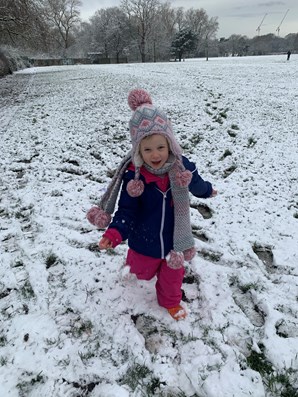Our ANSD experience
Published Date: 28 Jan 2021
When our daughter was born 5 years ago, deafness was something we barely ever thought about. I’d never met a deaf person before, we had no family history of deafness, and we just assumed we’d have a hearing child. Sybil passed the newborn hearing screening with flying colours, and we barely gave the results a second thought.
Fast-forward nine months, and we were being told that although Sybil passed the newborn screening, it was likely that she couldn’t hear, or at least couldn’t hear ‘normally’. “How?!” was the obvious first question… “How could she pass the newborn hearing screening, but actually be deaf?” Our audiologist told us he suspected auditory neuropathy spectrum disorder (ANSD), and we’d need another test, an auditory brainstem response (ABR) test, to confirm this. Our heads were spinning as we googled ANSD. Luckily, we stumbled across the National Deaf Children’s Society and their resources helped us understand a bit more about this confusing condition.
ANSD occurs when sounds are received normally by the cochlea, but become disrupted as they travel to the brain. Since it’s a spectrum, the levels of deafness can range from mild to profound loss. Sounds heard may also be distorted, like a poorly tuned radio, making it very difficult to pick up speech sounds, especially in high levels of background noise. Hearing aids can help, or may just amplify the distorted sounds.
We called the Helpline, who connected us with an audiology advisor. She was invaluable in helping us understand the diagnosis process and what we could expect next. Sybil had already passed an otoacoustic emission test (similar to the test carried out in the newborn screening), showing that the outer hair cells of her cochlea were responding normally. However now she needed an ABR, which would tell us whether or not the sounds picked up by her ear were being transmitted from the cochlea to her brain. As you’ve probably guessed, Sybil’s ABR was ‘absent’, meaning that the sounds were indeed not reaching her brain. We will never really know how much sound Sybil heard prior to getting her cochlear implants at 18 months old. We never observed her responding to any noises, even when using hearing aids, but our audiologist explained that she might have intermittently heard some distorted sound.
As for the cause of Sybil’s ANSD, we were fortunate to get an answer. When she underwent cochlear implantation, we were invited to take part in the 100,000 Genomes Project. This is a research project aiming to sequence 100,000 genomes from around 85,000 NHS patients affected by rare conditions (including ANSD) or cancers. My background is in biology and genetics, so I was pretty chuffed to be part of the project! We received the initial results a couple of years after signing up – both Sybil’s dad and I had mutations in our otoferlin genes, which Sybil had inherited from both of us. Otoferlin is necessary for normal hearing, and Adam and I could hear because we each had one normal copy of the gene to compensate for our mutated versions. It was explained that any other children we had would have a 25% chance of inheriting both mutated otoferlin genes and having ANSD. This didn’t affect our decision to have another child, and our son was born hearing in 2018.
To anyone facing a diagnosis of ANSD, I’d say that although it is a lot to get your head around, there’s nothing that your child can’t achieve with the right support!
